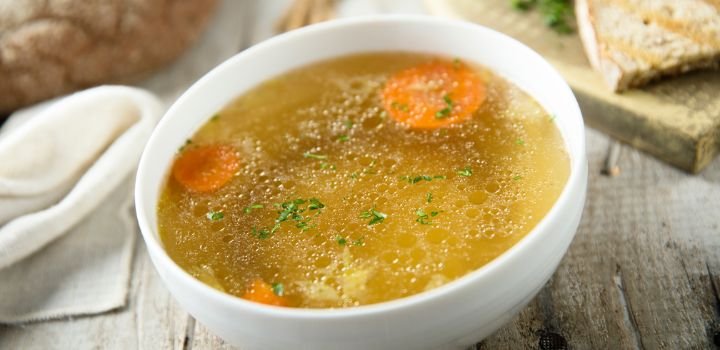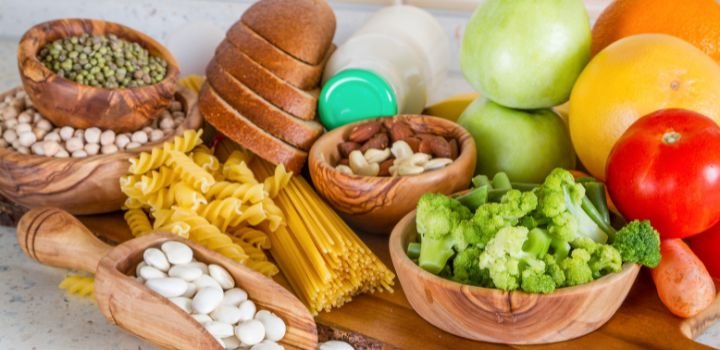With the global outbreak of the COVID-19 pandemic, immune support has risen to be one of the most desired health benefits consumers want from products. With the increased interest in immune health, consumers are becoming more familiar with beta glucans. While beta glucan products are growing in the market, confusion still exists among the different sources of beta glucans, the benefits, and the effect they can provide, particularly for immune health.
What exactly is a beta glucan?
Simply put, it is a fiber. More technically speaking, it is a naturally occurring complex carbohydrate called a polysaccharide found in the cell walls of foods such as common baker’s yeast, cereal grains (like barley, oats, rye, and wheat), and in many types of mushrooms. Because the body does not produce this fiber on its own, beta glucans are only available by consuming the sources identified above. And often, to receive benefits, the beta glucans must be extracted from their source. Functional foods, beverages, and supplements are convenient formats in which to deliver beta glucans to consumers.
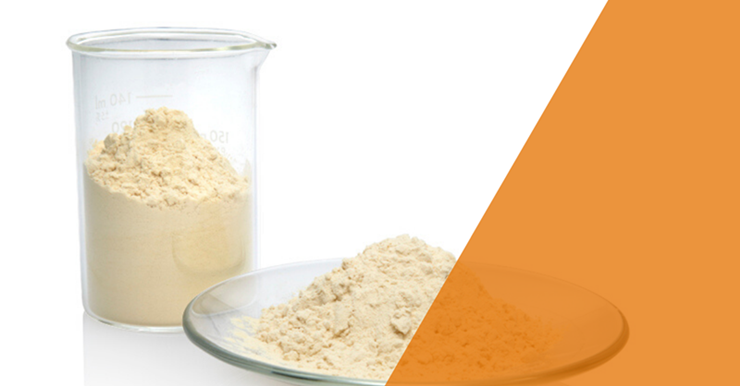
Sourcing beta glucans
When researching and evaluating beta glucans for use in immune health-focused functional foods, beverages, and supplements, it is crucial to understand that the variations in source, strain, and chemical structure all play an essential role in the benefit they may provide. Importantly, when it comes to immune health benefits, not all beta glucans are created equal. To help shed some light on the different types of beta glucans, in this article, we: 1. Compare three types of beta glucans (those from cereal, mushroom, and yeast) to better understand and differentiate between them. 2. Examine baker’s yeast beta glucan for immune health benefits and discuss why clinical research is vital.
Different structures, different benefits
As mentioned, different benefits are associated with various sources of beta glucans. It is the chemical characteristics of each type of beta glucan that affect biological activity. Each type of beta glucan is structured with a different molecular backbone and level of branching. The chart below shows the structure and biological differences between more common cereal, mushroom, and baker’s yeast beta glucans.
The benefits of beta glucans
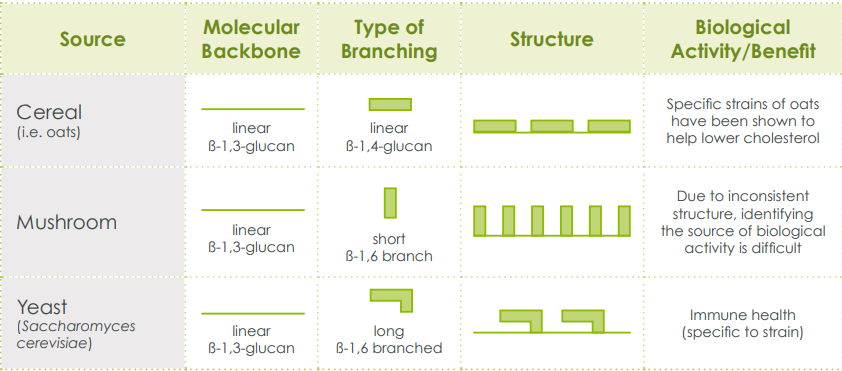
As the chart shows us, the structure can impact the associated health benefits of beta glucans, but let’s take a closer look at the differences, including the role strain plays in biological activity.
1. Cereal beta glucans Structure and benefits:
The predominant cereal grain consumed for its beta glucan content is oats, which provides a beta glucan with a linear molecular structure of ß-1,3/ß-1,4. The research: Unlike beta glucans from other sources, those derived from oats have not been shown to provide significant immune health benefits. Instead, studies have confirmed that certain oat beta glucans can help lower cholesterol levels and provide heart health benefits. The degree of cholesterol reduction depends upon the particular strain of beta glucan.
2. Mushroom beta glucans Structure and benefits:
The molecular structure of beta glucans derived from mushrooms is varied and inconsistent; the result is difficult to characterize their efficacy. Mushroom-derived beta glucan is with a ß-1,3-D-glucan backbone comprising very short ß-1,6 side chains. The research: Although mushroom beta glucans are associated with immune health benefits, research shows that their potency is lower than that of certain well-studied baker’s yeast beta glucans. The chemical makeup of each type of mushroom may vary. The biological activities of the various mushroom beta glucans likely depend on the chemical characteristics of different kinds of mushrooms. Further clinical research is needed to understand how each type of mushroom beta glucan works fully.
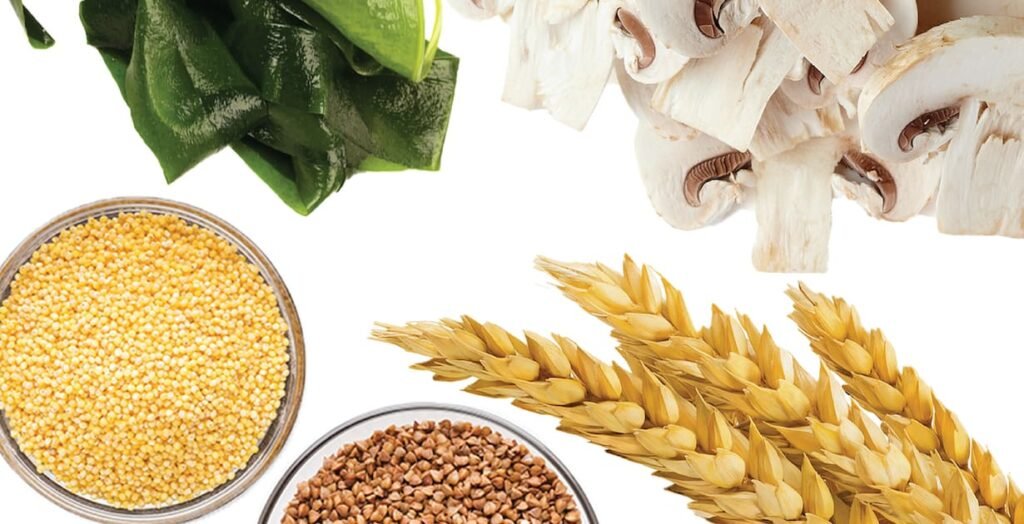
3. Yeast beta glucans Structure and benefits:
Multiple strains of yeast produce beta glucans (i.e., baker’s yeast, brewer’s yeast). Each strain of yeast produces beta glucan with a distinct composition and linkage pattern. Beta glucan from baker’s yeast (Saccharomyces cerevisiae) has a ß-1,3 glucan backbone with long branches of ß-1,6 glucan side chains. The research: Numerous biomarker, mechanism-of-action, and clinical research studies have revealed that the beta glucans present in certain strains of baker’s yeast are linked to immune health benefits. These health benefits are dependent on the specific strain and evidence it is supported and the specific process used in the production of the beta glucan.
What to look for in a baker’s yeast beta glucan for immunity
Manufacturing processes and research are essential to determining efficacy. Beyond understanding the role source, structure, and strain play on the benefits of a beta glucan, the method(s) used to extract and manufacture beta glucans derived from a specific strain of baker’s yeast is a key determinant on the immune system. This is because the manufacturing process can impact the structure of a beta glucan and thus its health benefits. What does this mean? This further emphasizes the importance of research. It means that when evaluating a baker’s yeast beta glucan, you should look for clinical research that supports the ingredient’s mechanism of action and provides biomarker, safety, and efficacy data that demonstrates its effectiveness. This research must be specific to that ingredient (or strain) and its extraction process because, as outlined, these attributes make a difference in efficacy.

When sourcing a baker’s yeast beta glucan for immunity-fortifying foods, beverages, and supplements, the research behind it will bring the different quality of a product. Multiple peer-reviewed, published, high-quality clinical studies, with consistent outcomes on that particular baker’s yeast beta glucan, are proven effective for the immune system.
Other questions to ask about beta glucans for immune health:
• What is the source and strain of the beta glucan?
• Has the mechanism of action been explained, defined, or published?
• What has the research found?
• Is it safe, and how has safety been verified?
What’s the best source of baker’s yeast beta glucan for immune health?
Hiyeast beta glucan is a natural immune health ingredient. Hiyeast® is a yeast beta 1,3/1,6 glucan. Hiyeast beta glucan is extracted from the cell wall of a proprietary strain of baker’s yeast (Saccharomyces cerevisiae). Highly purified, a variety of animal tests that support Hiyeast beta glucan have confirmed the safety and efficacy of this immune health ingredient. Research shows Hiyeast is a highly effective yeast beta glucan manufacturer for nutritional use in functional foods, beverages, and supplements and demonstrates health benefits.




